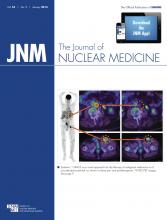Research ArticleBasic Science Investigations
The Low Hepatic Toxicity per Gray of 90Y Glass Microspheres Is Linked to Their Transport in the Arterial Tree Favoring a Nonuniform Trapping as Observed in Posttherapy PET Imaging
Stephan Walrand, Michel Hesse, Carlo Chiesa, Renaud Lhommel and Francois Jamar
Journal of Nuclear Medicine January 2014, 55 (1) 135-140; DOI: https://doi.org/10.2967/jnumed.113.126839
Stephan Walrand
1Nuclear Medicine, Molecular Imaging, Radiotherapy and Oncology Unit (MIRO), IECR, Université Catholique de Louvain, Brussels, Belgium; and
Michel Hesse
1Nuclear Medicine, Molecular Imaging, Radiotherapy and Oncology Unit (MIRO), IECR, Université Catholique de Louvain, Brussels, Belgium; and
Carlo Chiesa
2Nuclear Medicine, National Cancer Institute, IRCCS Foundation, Milan, Italy
Renaud Lhommel
1Nuclear Medicine, Molecular Imaging, Radiotherapy and Oncology Unit (MIRO), IECR, Université Catholique de Louvain, Brussels, Belgium; and
Francois Jamar
1Nuclear Medicine, Molecular Imaging, Radiotherapy and Oncology Unit (MIRO), IECR, Université Catholique de Louvain, Brussels, Belgium; and

Data supplements
Supplemental Data
Files in this Data Supplement:
In this issue
Journal of Nuclear Medicine
Vol. 55, Issue 1
January 1, 2014
The Low Hepatic Toxicity per Gray of 90Y Glass Microspheres Is Linked to Their Transport in the Arterial Tree Favoring a Nonuniform Trapping as Observed in Posttherapy PET Imaging
Stephan Walrand, Michel Hesse, Carlo Chiesa, Renaud Lhommel, Francois Jamar
Journal of Nuclear Medicine Jan 2014, 55 (1) 135-140; DOI: 10.2967/jnumed.113.126839
The Low Hepatic Toxicity per Gray of 90Y Glass Microspheres Is Linked to Their Transport in the Arterial Tree Favoring a Nonuniform Trapping as Observed in Posttherapy PET Imaging
Stephan Walrand, Michel Hesse, Carlo Chiesa, Renaud Lhommel, Francois Jamar
Journal of Nuclear Medicine Jan 2014, 55 (1) 135-140; DOI: 10.2967/jnumed.113.126839
Jump to section
Related Articles
Cited By...
- Normal-Tissue Tolerance to Radiopharmaceutical Therapies, the Knowns and the Unknowns
- A Microdosimetric Analysis of Absorbed Dose to Tumor as a Function of Number of Microspheres per Unit Volume in 90Y Radioembolization
- 90Y Hepatic Radioembolization: An Update on Current Practice and Recent Developments
- Personalized Dosimetry with Intensification Using 90Y-Loaded Glass Microsphere Radioembolization Induces Prolonged Overall Survival in Hepatocellular Carcinoma Patients with Portal Vein Thrombosis
- A Hepatic Dose-Toxicity Model Opening the Way Toward Individualized Radioembolization Planning
- Pretreatment Dosimetry in HCC Radioembolization with 90Y Glass Microspheres Cannot Be Invalidated with a Bare Visual Evaluation of 99mTc-MAA Uptake of Colorectal Metastases Treated with Resin Microspheres






